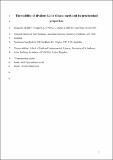The stability of divalent Ge in silicate melts and its geochemical properties
Abstract
The oxidation state of Ge in silicate glasses, quenched from melts, was determined by X-ray absorption spectroscopy. The melts were equilibrated over the range of relative oxygen fugacities (fO2) from IW -3 to IW + 10, where IW is the iron-wüstite oxygen buffer in logarithmic units. X-ray absorption near edge structure (XANES) spectra of the samples show that over the range in fO2 from IW -2.8 to IW + 2.4, the Ge4+/(Ge2+ + Ge4+) ratio increases from 0.05 to 0.95. Modelling of extended X-ray absorption fine structure (EXAFS) gives the Ge2+–O bond length as 1.89 ± 0.03 Å. Olivine–melt partitioning experiments were also conducted, which show that Ge2+ is highly incompatible, with DGe2+ol/melt < 0.005, whereas DGe4+ol/melt is ∼ 1, where D is the partition coefficient. The geochemical properties of Ge during the magmatic differentiation of the Moon and other reduced rocky planets and achondrite parent bodies will therefore be entirely different to that familiar from terrestrial examples. In particular, the incompatible nature of Ge2+ may explain the anomalous enrichment of Ge in KREEP basalts.
Citation
Mare , E , O'Neill , H S C , Berry , A & Glover , C 2020 , ' The stability of divalent Ge in silicate melts and its geochemical properties ' , Chemical Geology , vol. 532 , 119306 . https://doi.org/10.1016/j.chemgeo.2019.119306
Publication
Chemical Geology
Status
Peer reviewed
ISSN
0009-2541Type
Journal article
Description
HON gratefully acknowledges funding from the Australian Research Council through grant FL130100066.Collections
Items in the St Andrews Research Repository are protected by copyright, with all rights reserved, unless otherwise indicated.

